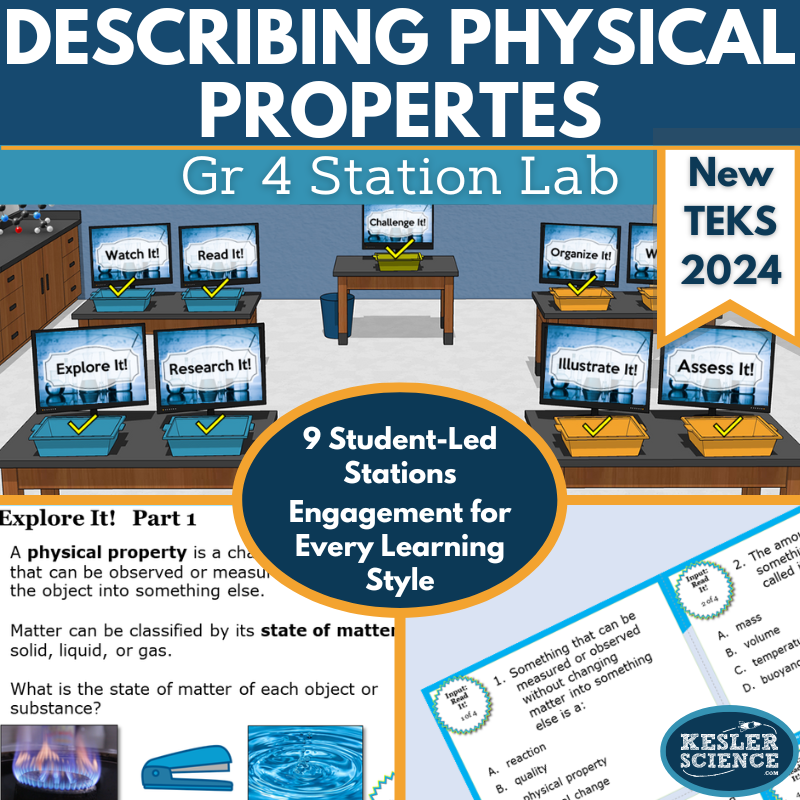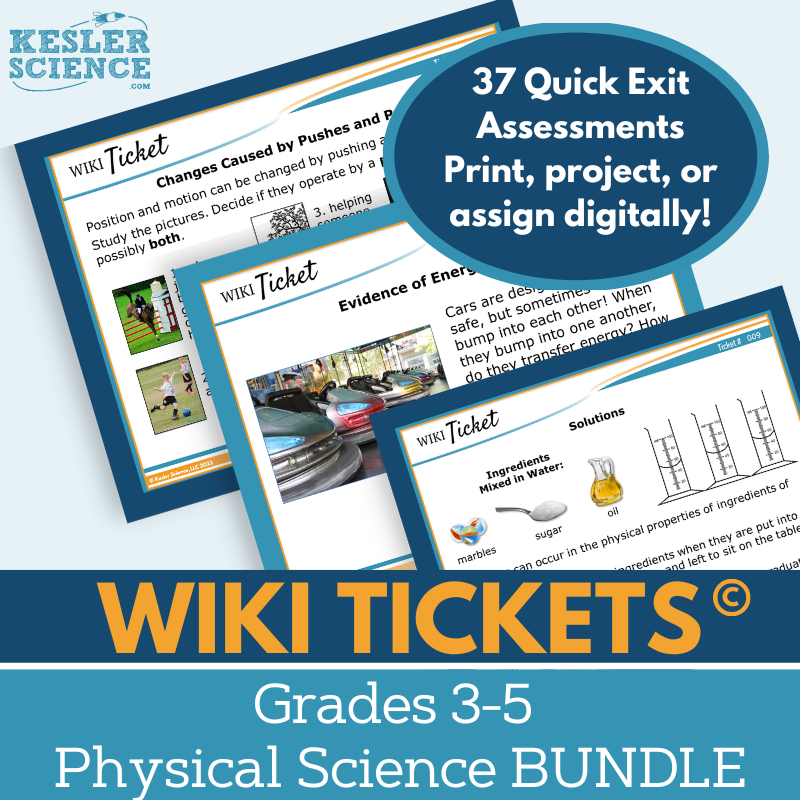Describing Physical Properties Activities for 4th Grade Science
This 4th-grade chemistry unit helps students explore physical properties like temperature, mass, magnetism, density, and physical state to classify matter. The resources below will give students a comprehensive understanding of physical properties of matter. All of the following materials are also included in the Kesler Science Membership.
The Kesler Science 4th grade chemistry unit on classifying and describing matter helps students explore physical properties such as temperature, mass, magnetism, relative density, and physical state. The lesson includes editable PowerPoints, worksheets, student-choice projects, and assessments, all designed for differentiated, student-led learning. It follows the 5E model with activities that engage, explore, explain, elaborate, and evaluate.
Students answer the key question: "In what ways are physical properties used for classification of matter?" The unit features nine differentiated exploration stations, including hands-on demos, reading passages in English and Spanish, interactive websites, and video discussions. Output stations provide opportunities for students to demonstrate their understanding through activities like card sorts, written responses, and illustrations.
Additional materials include interactive notebooks, teacher files, and extension activities for early finishers. The unit is aligned with the 2021 TEKS 4.6A standard and is suitable for both in-class and virtual learning. Assessment questions are updated for STAAR 2.0, with options for modified versions.
The Kesler Science 4th grade chemistry unit on classifying and describing matter helps students explore physical properties such as temperature, mass, magnetism, relative density, and physical state. The lesson includes editable PowerPoints, worksheets, student-choice projects, and assessments, all designed for differentiated, student-led learning. It follows the 5E model with activities that engage, explore, explain, elaborate, and evaluate.
Students answer the key question: "In what ways are physical properties used for classification of matter?" The unit features nine differentiated exploration stations, including hands-on demos, reading passages in English and Spanish, interactive websites, and video discussions. Output stations provide opportunities for students to demonstrate their understanding through activities like card sorts, written responses, and illustrations.
Additional materials include interactive notebooks, teacher files, and extension activities for early finishers. The unit is aligned with the 2021 TEKS 4.6A standard and is suitable for both in-class and virtual learning. Assessment questions are updated for STAAR 2.0, with options for modified versions.
This student-led station lab covers the 2021 TEKS 4.6A standard on describing and classifying the physical properties of matter. Designed for 4th grade, it engages students with nine modular activities that foster independent learning. The stations allow students to explore physical properties of matter and classify them through a variety of tasks. Teachers facilitate learning while students take the lead, engaging in activities such as reading passages, watching videos, and using digital tools like PowerPoint or Google Slides.
The lab includes both input and output stations. Input stations like “Explore It!” and “Watch It!” allow students to interact with information through activities, videos, and readings. Output stations, such as “Organize It!” and “Illustrate It!” let students apply their learning by drawing, writing, or working hands-on with materials. “Assess It!” challenges students to demonstrate understanding with task cards, while the "Challenge It!” bonus station offers extension activities for advanced learners.
This resource is versatile for both in-person and virtual learning environments, with activities requiring minimal prep and resources you likely already have.
This student-led station lab covers the 2021 TEKS 4.6A standard on describing and classifying the physical properties of matter. Designed for 4th grade, it engages students with nine modular activities that foster independent learning. The stations allow students to explore physical properties of matter and classify them through a variety of tasks. Teachers facilitate learning while students take the lead, engaging in activities such as reading passages, watching videos, and using digital tools like PowerPoint or Google Slides.
The lab includes both input and output stations. Input stations like “Explore It!” and “Watch It!” allow students to interact with information through activities, videos, and readings. Output stations, such as “Organize It!” and “Illustrate It!” let students apply their learning by drawing, writing, or working hands-on with materials. “Assess It!” challenges students to demonstrate understanding with task cards, while the “Challenge It!” bonus station offers extension activities for advanced learners.
This resource is versatile for both in-person and virtual learning environments, with activities requiring minimal prep and resources you likely already have.
The Describing Physical Properties Student Choice Projects align with the 2021 TEKS standard 4.6A for chemistry, allowing 4th graders to select a project based on their preferred output style. The project page presents six student-led options plus a “design your own” project, with a customizable grading rubric for teacher, peer, or self-assessment. Teachers can adjust the rubric to meet their grading needs.
The projects offer flexible, multimodal choices, allowing students to creatively demonstrate their understanding. The resource includes nine project options, a Teacher Directions page with helpful tips, and editable rubric pages to assess vocabulary, concepts, presentation, clarity, and accuracy. Differentiation is built in, with modified options for students who need additional support and advanced projects for those seeking a challenge. Many projects can be completed using standard classroom supplies or digitally.
The Describing Physical Properties Student Choice Projects align with the 2021 TEKS standard 4.6A for chemistry, allowing 4th graders to select a project based on their preferred output style. The project page presents six student-led options plus a “design your own” project, with a customizable grading rubric for teacher, peer, or self-assessment. Teachers can adjust the rubric to meet their grading needs.
The projects offer flexible, multimodal choices, allowing students to creatively demonstrate their understanding. The resource includes nine project options, a Teacher Directions page with helpful tips, and editable rubric pages to assess vocabulary, concepts, presentation, clarity, and accuracy. Differentiation is built in, with modified options for students who need additional support and advanced projects for those seeking a challenge. Many projects can be completed using standard classroom supplies or digitally.
The Physical Properties of Matter Science and ELA Integrated Writing Activity engages 4th grade students in exploring the physical properties of a ping pong ball and marble through a skit or drama format. This TEKS-aligned activity encourages students to measure, compare, and contrast properties like mass, volume, states, temperature, magnetism, and buoyancy. This creative, low-prep activity is designed for both in-person and virtual learning, enhancing science reasoning and writing skills.
Included in the resource are teacher directions, a project guide, rubrics, projection and handouts, and a digital interactive version for platforms like Google Slides. The writing prompt can be used for cross-curricular activities, pre-assessments, student choice projects, differentiation, and extra credit. This activity also serves as a great option for formative assessment and TELPAS samples.
The Physical Properties of Matter Science and ELA Integrated Writing Activity engages 4th grade students in exploring the physical properties of a ping pong ball and marble through a skit or drama format. This TEKS-aligned activity encourages students to measure, compare, and contrast properties like mass, volume, states, temperature, magnetism, and buoyancy. This creative, low-prep activity is designed for both in-person and virtual learning, enhancing science reasoning and writing skills.
Included in the resource are teacher directions, a project guide, rubrics, projection and handouts, and a digital interactive version for platforms like Google Slides. The writing prompt can be used for cross-curricular activities, pre-assessments, student choice projects, differentiation, and extra credit. This activity also serves as a great option for formative assessment and TELPAS samples.
The WIKI Tickets© Physical Science Set offers 37 formative assessments for 3rd–5th grade science, designed to check student understanding in an engaging and colorful way. Each topic comes with five formats: a full-screen display for projection, three handout versions (full, split, and quarter-page sizes), and a digital interactive version compatible with PowerPoint and Google Slides.
Aligned with NGSS and TEKS standards for upper elementary science, this set covers various topics, including changes caused by pushes and pulls, energy transfer, forms of energy, properties of matter, and force interactions. Some topics feature multiple assessments, and each set includes a bonus table of contents for easy alignment reference.
These assessments are suitable for both in-person and virtual learning, allowing students to engage with the material on campus or remotely. WIKI Tickets© can be used as exit tickets, bellringers, or to check understanding at any time. Whether projected on a screen, printed as handouts, or assigned digitally, they provide versatile tools for gauging student progress.
The WIKI Tickets© Physical Science Set offers 37 formative assessments for 3rd–5th grade science, designed to check student understanding in an engaging and colorful way. Each topic comes with five formats: a full-screen display for projection, three handout versions (full, split, and quarter-page sizes), and a digital interactive version compatible with PowerPoint and Google Slides.
Aligned with NGSS and TEKS standards for upper elementary science, this set covers various topics, including changes caused by pushes and pulls, energy transfer, forms of energy, properties of matter, and force interactions. Some topics feature multiple assessments, and each set includes a bonus table of contents for easy alignment reference.
These assessments are suitable for both in-person and virtual learning, allowing students to engage with the material on campus or remotely. WIKI Tickets© can be used as exit tickets, bellringers, or to check understanding at any time. Whether projected on a screen, printed as handouts, or assigned digitally, they provide versatile tools for gauging student progress.
Year-Round Resources
These year-round activities will increase your students' understanding of many middle school science topics. All of these activities are also included in the Kesler Science Membership.
Visual Data & Graphing
You're not alone if your students struggle with understanding graphs, charts, and tables. It's a skill that takes an enormous amount of practice. This resource will help students build a strong foundation in analyzing data and creating their own data visualizations.
Bell Ringers and Warm-Ups
These middle school science bell ringers are an excellent way to engage your students as soon as they walk into your classroom. This comprehensive FULL YEAR resource includes everything you need to start off each science class with an interesting warm-up activity.
Review Board Games
Each game board has been carefully designed to keep students engaged. There are 10 different action spaces on each board and dozens of question cards. All of the actions are related to science concepts and keep the students motivated throughout the game.
Each game is ready to play. Simply print out the board and the cards and let the students enjoy reviewing nine different units.
Essential Questions and Standards
Below are the essential questions and standards associated with the lessons and activities included in the atoms unit. This topic is only one of more than 100 middle school science topics included in the Kesler Science Membership.
-
Can you describe the physical properties of matter?
-
How are physical properties used for classification of matter?
-
TEKS Science - 4.6A Describing Physical Properties
Kesler Science Membership
Imagine never having to search for another middle school science lesson again. The membership gives you access to ALL of the Kesler Science products in one place (Yes, including everything above).
Say goodbye to long hours of lesson prep.











